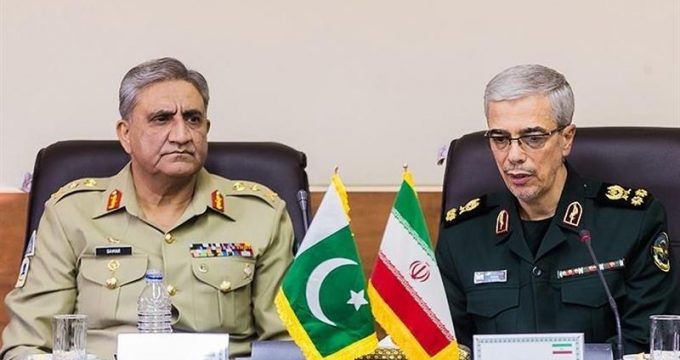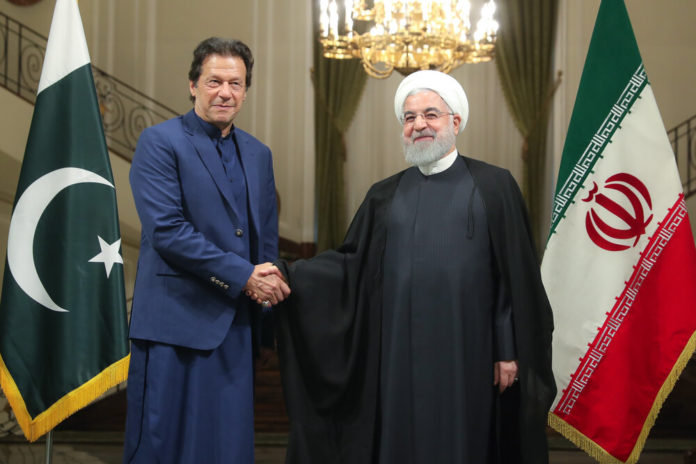Pakistan-Iran relations have remained mired in half-hearted initiatives, coupled with misgivings and suspicions. Notwithstanding the fact that they share more than a 1000-kilometre border, common denominator of religion and an irritant-free geostrategic commonality, they have been poles apart. Joint economic ventures as well as trade and travel format are Greek at large.
Big-ticket projects were a non-starter, as the Economic Cooperation Organisation and the Iran-Pakistan-India gas pipeline consortiums are a case in point. This is so because the lens of interaction differs among them, and they for reasons of realpolitik do not see from the same prism. This myopic approach has undermined bilateral growth and vis-à-vis regional integration.
Under the rare convert of ‘your enemy is my enemy’ too, both the countries have gained a leap forward in forging consensus over Afghanistan. The exit of the United States from the southwest Asian landlocked state has further cemented their understanding. Irrespective of the fact they have their own moles all around in the war-weary country, and differ at length in geo-political realms, the threat of terrorism is bringing them on the same page. This is a commonality of interests, per se.
This new mosaic could see them cooperating on both sides of Balochistan where they had traditionally opted for flexing of muscles, and deep inside Afghanistan in the Pashtun and Tajik-dominated areas to keep their stakes alive. Yet, a glance of interaction suggests that they overwhelmingly are hostage to extra regional forces, and in an inertia of their own.
Let’s review dynamics in the spheres of defence, geopolitics, travel and economy, in an attempt to trace their new-found love. In retrospection, also analyse what factors failed the ambitious dream of the US$7.5 billion Iran-Pakistan-India gas pipeline:

DEFENCE AND GEO-POLITICS
The landmark visit of Iran’s army chief, Maj. Gen. Mohammad Hossein Bagheri to Pakistan in Oct 2021, along with a high-powered delegation has rekindled hopes of wider cooperation. Surprisingly enough, this time the tarmac is defence coordination, marking a new phase in realpolitik as Washington takes a backseat in the region. It hints at a win-win geostrategic amalgamation for both the countries, and could turn around their level of relations to a new high.
If there isn’t any slip between the cup and the lip, both countries who nurse anti-American sentiments could open new vistas of broader regional understanding with China and Russia acting as peripheries of new bipolarity, at least in the region.
Islamabad sits conveniently in the Beijing camp as a harbinger of multi-billion dollar China-Pakistan Economic Corridor (CPEC) and likewise Tehran has inked deals worth $300 billion spanning over next two decades with China. This points out a new nexus of defence format, luckily enough with no adversary to fight in the region.
Maj. Gen. Bagheri’s rubbing of shoulders with Pakistan Army Chief Gen. Qamar Javed Bajwa marks a new phase in the military’s bilateralism. Gen Bajwa has been involved in ironing out geostrategic complications in the region, and is highly admired in Saudi Arabia and the United Arab Emirates, as well as the entire Arab world. This Persian amalgamation, thus, acquires immense significance.
Both the generals reportedly agreed to work on building ships and submarines and jointly undertake maritime security. What makes this understanding more startling is that Pakistan will also be working closely with the Iranian Maritime Security Center in Chahbahar, thus dispelling an impression of confrontation and animosity between Gwadar and Chahbahar ports.
Pakistan and Iran have a common cause to serve in Afghanistan and that is to prevent a civil war among different ethnic groups, and stem another exodus of sorts. Pakistan is already home to more than three million Afghan refugees, and a million or so are in Iran, too, which is not only an economic crunch but also a serious socio-security threat.
This is why Iran has prudently put off its differences with the Taliban. The militia too has obliged Tehran by appointing a Hazara, Mohammad Hassan Gheyasi, as deputy minister for public health in the cabinet. Likewise, keeping aside reservations for the Haqqani presence and role within the Taliban set-up, the Iranian establishment is willing to walk the extra miles for serenity.
Pakistan has vice versa sought Iran’s help in exterminating Jaish-e-Adl, a radical Salafi group holed in Iranian Balochistan, which reportedly operates on both sides through its abettors. Pakistan also has serious concerns over extremists groups housed in Pakistan such as Zainabia, which had been instrumental in fighting in Syria at the alleged behest of Iranian secret agencies. Jundullah, Tehrik-e-Taliban Pakistan, Islamic State-Khorasan and Al Qaeda are other irritants that will keep both the states bogged down to stitch a broad intelligence gathering mechanism. This is where the renewed defence and intelligence nexus lies.

ECONOMIC
They say, it’s late but never too late! So is the case with the two sleeping giants of the region who have much to relish in the geo-economics spheres, but have lost decades owing to their strait-jacket idio-(bureau)-cracy. Alas, Pakistan and Iran have agreed to take measures to expand trade and take it over the turf of $5 billion by 2023. At the moment, it is merely 10 percent of the projected figure i.e. $500 million.
A joint communiqué, after a series of interactions, says that ‘all out efforts’ shall be made to remove hurdles within three months i.e., by January 2022, to buoy economic projections, which are in limbo since 2006 when both the countries signed the preferential trade agreement (PTA).
Ironically, Pakistan has a very small export basket with Iran with rice comprising 60 percent of the total trade.
Tehran enjoys tariff concessions on more than 300 products from Pakistan, whereas in lieu it generously accepts a similar number of goods in reciprocity. Under the PTA nexus rice, fruits, cotton, cotton yarn, pharmaceutical products and cutlery have a lavish market in Iran. Saffron, carpets, dry fruits and small machinery, likewise, have a great demand in Pakistan.
TRAVEL
Despite sharing a border of over 670 miles – and that too porous at more than 15 points – from where human interaction can take place at ease, there is absolutely no mechanism to promote tourism. The only point of legal human traffic is the Taftan-Sistan border check post, which is usually used by pilgrims travelling onward to Mashhad and Qom.
It is another untold story of human misery as for decades it had lacked basic civic amenities, and the journey from Quetta to Taftan is no more than a nightmare, often pinched with serious security threats. Though things are picking up in terms of provisions on the border front, it is in no match to what similar border posts have in essence worldwide and in the region.
So is the fate of the Turkey-Iran-Pakistan trans-country railway line under the prefix of Regional Cooperation for Development (RCD). It was an over-eulogised economics troika venture that wasn’t even kick-started. Later, it was glorified as Economic Cooperation Organisation and another filler was mooted to run a goods and passenger train from Istanbul to Islamabad via Tehran. It is still nowhere in sight. Whereas in the same time frame, Russia was able to build a wonder of the world by running a six-night journey train across its Siberian frozen lands. Initiative and political will counts!
IPI GAS PIPELINE
Mani Shankar Aiyar, the then Indian petroleum minister, after meeting Prime Minister Shaukat Aziz in June 2005 in Islamabad, sounded cynical when he pronounced, “the pipeline may not be a reality as yet but it has at least become a certainty.” How true, he was.
The project after remaining in doldrums for more than a decade now rests in peace in the annals of history, with its hundreds of kilometres of pipeline buried deep underneath. This is an un-ceremonial burial of geo-economics.
The Iran–Pakistan–India $7.5 billion gas project, widely then referred as Peace Pipeline, was a 2,775-kilometre pipeline to deliver natural gas from Iran to Pakistan, and then carry the precious energy trance onward to India. But it was primarily a victim of United States’ sanctions on Iran, with India and Pakistan opting to stay away without burning their fingers.
The gas from Iran’s Pars gas field across the Pakistani province of Balochistan to India was fraught with misgivings since day one. Mutual suspicions haunted the trilateral mega project and was literally derailed at the hands of vested dynamics.
Delhi was lured by Washington into the nuclear club, and Pakistan caved under pressure. The US feared that the money from the pipeline project would fuel Iran’s nuclear programme, and thus it was scuttled.
The affordable, unlimited low-cost supply of gas was reportedly enough for at least next 100 years. India was supposed to buy 70 per cent of the gas emanating from Iran while 30 per cent would end up in Pakistan.
The project could have won Pakistan $600 million annually as royalty from India. But Islamabad was aptly reminded by Washington that $700 million yearly US largesse as part of the Bush administration’s three-billion-dollar loan would be scrapped if Pakistan went ahead with the deal. Politics of aid triumphed over geo-economics.
With the annulment of troika, the project is still experimenting with bilateral modalities but in vain. It is current history that Pakistan inked a controversial multi-billion (compromised-cum-compressed) gas-deal with a far-off Arab country to import gas, which is eating up our forex reserves with impunity. So much so for regional integration and Pakistan-Iran relations.





